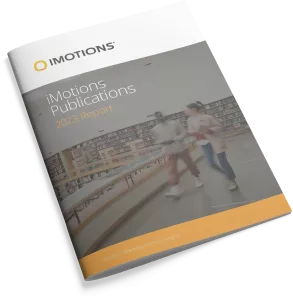-
Eyes on Prevention: An Eye-Tracking Analysis of Visual Attention Patterns in Breast Cancer Screening Ads
Strong communication is central to the translation of breast cancer screening availability into uptake. This experiment tests the role of design features of screening advertisements in directing visual attention in screening-eligible women (≥40 years). To this end, a within-subjects eye-tracking experiment (N = 30) was conducted in which women viewed six static public service advertisements. […] -
AI for Learners’ Emotions — A Perspective Approach of Analysis During Online Assessments
Distance learning and assessment through online platforms have emerged as a complementary approach to traditional classroom-based activities in the contemporary educational landscape. These platforms add significant value to conventional learning and evaluation methods by offering flexibility and accessibility. The increasing demand for intelligent online platforms has led to the integration of innovative techniques such as […] -
Evaluation of Visual Behavior and Consumer Preferences of Zamorano Brand Cold Cuts in Tegucigalpa, Honduras
The decline in sales of Zamorano cold cuts in supermarkets in Tegucigalpa highlighted the need to evaluate factors that could be affecting their positioning. The purpose of this study was to identify which label attracts the most visual attention from consumers, determining areas for improvement and analyzing the factors that influence purchasing decisions. The research […] -
The ‘Live’ Gaze: A Neuromarketing and Eye-Tracking Analysis of Consumer Attention and Impulse Buying on Shopee Live and TikTok Shop in Indonesia
Livestream commerce (LSC) has redefined digital retail in Southeast Asia, with Indonesia as its most competitive market. The two dominant platforms, Shopee Live and TikTok Shop, leverage vastly different user interfaces and engagement philosophies—commerce-first versus contentfirst, respectively. However, the precise cognitive and affective mechanisms by which these platforms guide consumer attention and trigger impulse purchases […] -
ROGER:Visualizing Voice Records to Enhance Team Communication Trainings for High-Stress Situations
Effective communication is essential in high-stress environments but stress often disrupts the flow of information and leads to miscommunication. While scenario-based training exercises are widely used, post-hoc reflection and analysis of verbal interactions remain challenging due to overlapping speech, limited analysis time, and the dynamic nature of these situations. This paper introduces ROGER, a novel […] -
Exploring the Impact of Message Framing on Donation Behavior Through Emotions in Sport CSR: The Moderating Roles of Perceived CSR Motives and Team Identification Through Biometric Facial Expression Analysis
Despite extensive research on corporate social responsibility (CSR), the effects of message framing within sport CSR remain unexplored. This study bridges this gap by examining how message framing impacts donation behavior through emotions, using advanced biometric facial expression analysis. Results indicate that negatively framed messages, which evoke sadness, lead to higher donation amounts than that […] -
The Influence of Conscientiousness and Context on the Emotional Response during Understanding
In this exploratory study, we use a logistic multilevel model to examine the interplay between personality, emotions, and understanding. The impact of Conscientiousness, a Big Five Personality trait, on emotional responses during riddle-solving attempts was investigated in 101 participants, who each tackled 15 riddles remotely via Zoom. Video recordings were analyzed using iMotions with AFFDEX […] -
Measuring Mental Effort in Real Time Using Pupillometry
Mental effort, a critical factor influencing task performance, is often difficult to measure accurately and efficiently. Pupil diameter has emerged as a reliable, real-time indicator of mental effort. This study introduces RIPA2, an enhanced pupillometric index for real-time mental effort assessment. Building on the original RIPA method, RIPA2 incorporates refined Savitzky–Golay filter parameters to better […] -
Deciphering Trust: Multi-Modal Affective Analysis in Dynamic Decision-Making Games
Investigating how trust is built and maintained is especially important as technological advances make scam and fraud easier and quicker to enact. Fields such as neuroeconomics, psychology, and computer science have devoted considerable attention to the roles that emotional expression possess in determining decision making, with many studies utilizing paradigms including trust games, negotiation games, […] -
Decoding consumer responses to anthropomorphic products using electroencephalography, skin conductance, and eye-tracking
Anthropomorphic product design is often assumed to increase consumer engagement, but its neural mechanisms and boundary conditions remain underexplored. This study employed a multimodal neuroscientific approach—electroencephalography (EEG), galvanic skin response (GSR), and eye-tracking—to examine how anthropomorphized versus non-anthropomorphized products influence consumer responses. Forty-four young adults viewed AI-generated images of beverages, backpacks, and smartphones. While anthropomorphic […]
Research Report 2024
In-depth look at the scientific landscape as powered by iMotions software, showcasing groundbreaking research and the impact of our tools in various scientific and industrial fields.

iMotions Science Resources
Looking for white papers, validation reports or research show casing iMotions Multimodal capabilities?
Share Your Research

850+ universities worldwide with an iMotions human behavior lab
73 of the top 100 highest ranked universities
710+ published research papers using iMotions
iMotions is used for some of the most interesting human behavior research studies carried out by top researchers around the world. Contact us to have your publication featured here.
The authors of these publications have used iMotions as a software tool within their research.
“Software should be cited on the same basis as any other research product such as a paper or a book; that is, authors should cite the appropriate set of software products just as they cite the appropriate set of papers” (Katz et al., 2020).
We therefore encourage you to cite the use of iMotions where appropriate.
How to cite iMotions
APA
iMotions (10), iMotions A/S, Copenhagen, Denmark, (2024).
Note: adjust the version and year where relevant.
5 Most Popular Blogs
Publications
Read publications made possible with iMotions
Blog
Get inspired and learn more from our expert content writers
Newsletter
A monthly close up of latest product and research news


